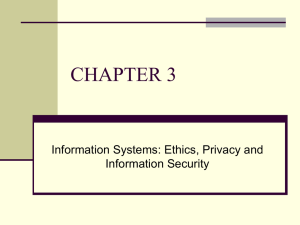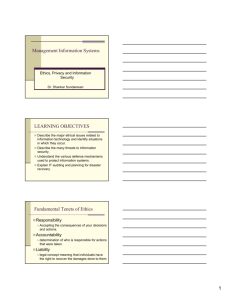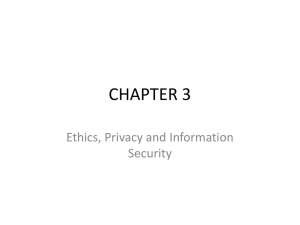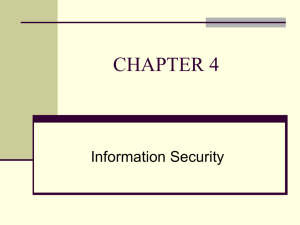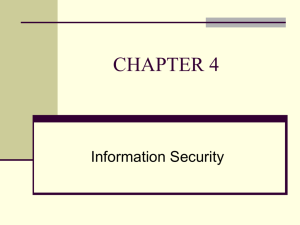Internal External
advertisement
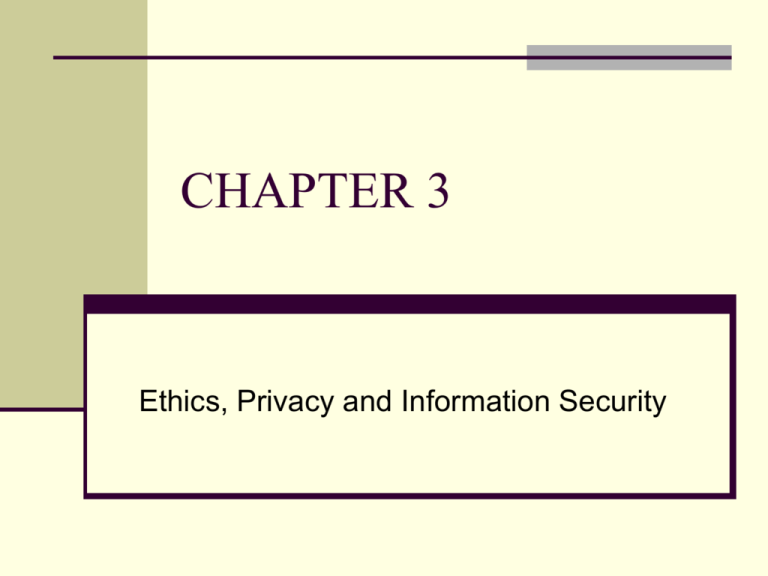
CHAPTER 3 Ethics, Privacy and Information Security CHAPTER OUTLINE 3.1 Ethical Issues 3.2 Threats to Information Security 3.3 Protecting Information Resources LEARNING OBJECTIVES Describe the major ethical issues related to information technology and identify situations in which they occur. Describe the many threats to information security. Understand the various defense mechanisms used to protect information systems. Explain IT auditing and planning for disaster recovery. TJX: The Worst Data Breach Ever? Ethical Issues Ethics Code of Ethics Fundamental Tenets of Ethics Responsibility Accountability Liability Unethical vs. Illegal What is unethical is not necessarily illegal. Ethics scenarios The Four Categories of Ethical Issues Privacy Issues Accuracy Issues Property Issues Accessibility Issues Privacy Issues How much privacy do we have left? Privacy Privacy. The right to be left alone and to be free of unreasonable personal intrusions. Court decisions have followed two rules: (1) The right of privacy is not absolute. Your privacy must be balanced against the needs of society. (2) The public’s right to know is superior to the individual’s right of privacy. Threats to Privacy Data aggregators, digital dossiers, and profiling Electronic Surveillance Personal Information in Databases Information on Internet Bulletin Boards, Newsgroups, and Social Networking Sites Data Aggregators, Digital Dossiers, and Profiling Electronic Surveillance Electronic Surveillance See "The State of Surveillance" article in BusinessWeek See the surveillance slideshow See additional surveillance slides And you think you have privacy? (video) Sense-through-the-Wall Personal Information in Databases Banks Utility companies Government agencies Credit reporting agencies Information on Internet Bulletin Boards, Newsgroups, and Social Networking Sites Social Networking Sites Can Cause You Problems Anyone can post derogatory information about you anonymously. (See this Washington Post article.) You can also hurt yourself, as this article shows. What Can You Do? First, be careful what information you post on social networking sites. Second, a company, ReputationDefender, says it can remove derogatory information from the Web. Protecting Privacy Privacy Codes and Policies Opt-out Model Opt-in Model 3.2 Threats to Information Security Factors Increasing the Threats to Information Security Today’s interconnected, interdependent, wirelessly-networked business environment Government legislation Smaller, faster, cheaper computers and storage devices Decreasing skills necessary to be a computer hacker Factors Increasing the Threats to Information Security (continued) International organized crime turning to cybercrime Downstream liability Increased employee use of unmanaged devices Lack of management support A Look at Unmanaged Devices Wi-Fi at McDonalds Hotel Business Center Wi-Fi at Starbucks Key Information Security Terms Threat Exposure Vulnerability Risk Information system controls Security Threats (Figure 3.1) Categories of Threats to Information Systems Unintentional acts Natural disasters Technical failures Management failures Deliberate acts (from Whitman and Mattord, 2003) Example of a threat (video) Unintentional Acts Human errors Deviations in quality of service by service providers (e.g., utilities) Environmental hazards (e.g., dirt, dust, humidity) Human Errors Tailgating Shoulder surfing Carelessness with laptops and portable computing devices Opening questionable e-mails Careless Internet surfing Poor password selection and use And more Anti-Tailgating Door Shoulder Surfing Most Dangerous Employees Human resources and MIS Remember, these employees hold ALL the information Social Engineering 60 Minutes Interview with Kevin Mitnick, the “King of Social Engineering” Kevin Mitnick served several years in a federal prison. Upon his release, he opened his own consulting firm, advising companies on how to deter people like him, See his company here Natural Disasters Deliberate Acts Espionage or trespass Information extortion Sabotage or vandalism Theft of equipment or information For example, dumpster diving Deliberate Acts (continued) Identity theft video Compromises to intellectual property Deliberate Acts (continued) Software attacks Virus Worm 1988: first widespread worm, created by Robert T. Morris, Jr. (see the rapid spread of the Slammer worm) Trojan horse Logic Bomb Deliberate Acts (continued) Software attacks (continued) Phishing attacks Phishing slideshow Phishing quiz Phishing example Phishing example Distributed denial-of-service attacks See botnet demonstration Deliberate Acts (continued) Software attacks (continued) Can you be Phished? How to Detect a Phish E-mail Is the email really from eBay, or PayPal, or a bank? As Spammers get better, their emails look more genuine. How do you tell if it’s a scam and phishing for personal information? Here’s how ... Is the email really from eBay, or PayPal, or a bank? As an example, here is what the email said: Return-path: <service@paypal.com> From: "PayPal"<service@paypal.com> Subject: You have 1 new Security Message Alert ! Note that they even give advice in the right column about security Example Continued – bottom of the email How to see what is happening View Source In Outlook, right click on email, click ‘view source’ In GroupWise, open email and click on the Message Source tab In Mozilla Thunderbird, click on View, and Source. Below is the part of the text that makes the email look official – the images came from the PayPal website. View Source – The Real Link In the body it said, “If you are traveling, “Travelling Confirmation Here” Here is where you are really being sent href=3Dftp://futangiu:futangiu@209.202.224.140/in dex.htm Notice that the link is not only not PayPal, it is an IP address, 2 giveaways of a fraudulent link. Another Example – Amazon View Source Deliberate Acts (continued) Alien Software Spyware (see video) Spamware Cookies Cookie demo Deliberate Acts (continued) Supervisory control and data acquisition (SCADA) attacks Wireless sensor What if a SCADA attack were successful? Northeastern U.S. power outage in 2003 Results of the power outage in NYC More results of power outage in NYC A Successful (Experimental) SCADA Attack Video of an experimental SCADA attack that was successful 3.3 Protecting Information Resources Risk! There is always risk! And then there is real risk! Risk Management Risk Risk management Risk analysis Risk mitigation Risk Mitigation Strategies Risk Acceptance Risk limitation Risk transference Risk Optimization Controls Physical controls Access controls Communications (network) controls Application controls Where Defense Mechanisms (Controls) Are Located Access Controls Authentication Something the user is (biometrics) Video on biometrics The latest biometric: gait recognition The Raytheon Personal Identification Device Something the user has Something the user does Something the user knows passwords passphrases Access Controls (continued) Authorization Privilege Least privilege Communication or Network Controls Firewalls Anti-malware systems Whitelisting and Blacklisting Intrusion detection systems Encryption Basic Home Firewall (top) and Corporate Firewall (bottom) How Public Key Encryption Works How Digital Certificates Work Communication or Network Controls (continued) Virtual private networking Secure Socket Layer (now transport layer security) Vulnerability management systems Employee monitoring systems Virtual Private Network and Tunneling Popular Vulnerability Management Systems Popular Employee Monitoring Systems Employee Monitoring System Business Continuity Planning, Backup, and Recovery Hot Site Warm Site Cold Site Information Systems Auditing Types of Auditors and Audits Internal External IS Auditing Procedure Auditing around the computer Auditing through the computer Auditing with the computer Chapter Closing Case
